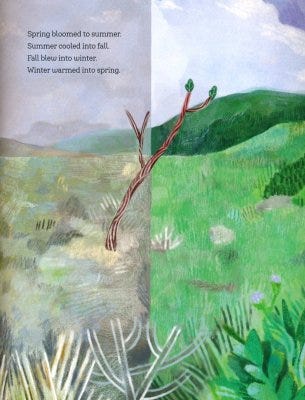Dear Friends,
I don’t have a time machine. None of us do (unless some of you are excellent secret keepers). And yet I can guarantee most of us are asked, at least occasionally, to do something that would require pulling such a lever and visiting another time.
I also don’t watch a lot of movies, but my understanding is that time machines are usually the source of complications, not solutions, right?
But what is this all about?
The Church & The Time Machine
This Sunday’s RCL is doing a lot of wrangling with ancestors and past downfalls, with throughlines and connections looking forward and back. It begins in our Old Testament reading when Moses seeks support and justification, asking God: “If I come to the Israelites and say to them, 'The God of your ancestors has sent me to you,' and they ask me, 'What is his name?' what shall I say to them?” God said to Moses, “I am who I am.” He said further, “Thus you shall say to the Israelites, 'I am has sent me to you.'” God also said to Moses, “Thus you shall say to the Israelites, 'The Lord, the God of your ancestors, the God of Abraham, the God of Isaac, and the God of Jacob, has sent me to you’” –
– and it carries us into Paul’s First Letter to the Corinthians, where Paul reminds the people that every generation faces its trials, but God remains faithful to God’s People –
– and finally to Jesus in the Gospel of Luke, asking the people whether they think they are any better or worse than those who came before them. You might face the same fate, he tells them: “but unless you repent, you will all perish just as they did.”
It turns out there has never been a moment when the People of God were not caught up with concern and comparison, looking backwards or forwards instead of looking right in front of them at their current wonderful gifts and terrible struggles – the only things they indeed had to work with. The same things that we today have to work with. From age to age, we are who we are and God is who God is.
And, it seems, who we are is often one of two things:
A. haughty folks with a superiority complex because oh, weren’t those people way back when so backwards and clueless
-or-
B. communities caught up in nostalgia and yearning for pasts that not only probably didn’t exist in the first place1, but definitely won’t ever exist again.
We see it today in the form of “wow look how racist our church forebears were, look how they didn’t believe in the ordination of women or LGBTQ people – we’ve fixed that” overstated positivism and “why don’t people come to church anymore, why are sports on Sunday mornings, why don’t people seem to think worship and church school is important - why can’t we go back” whining. Neither is totally true, but depending on the slant, these formulations make us either victors over or victims of the passage of time.
Posterity, Passivity, & Problem Solving
As a church school coordinator and consultant, the Time Machine Problem of Church Operations, as one might call it, comes up a lot in my life. No one has enough teachers or enough children or enough time with the children they do have. No one has enough money or resources. It’s unfixable.
Right?
Or maybe the problem is something else entirely. Maybe we are falling short on training, on confidence, on our own formation, which are all fixable things. Maybe we feel too married to the way we think we’re “supposed to” do things instead of breaking the fake rules. Maybe we’re so worried about doing things right that we’re forgetting to demonstrate our own passion for living our call as ministers of the Gospel.
Maybe we keep trying to time travel right to the good outcome instead of taking the year to fertilize that fig tree. Instead we cut it down. No fruit now, no fruit ever, we seem to say.2
I say all this because I have two classrooms: one where, week after week, we basically play by the rules. It’s a traditional Godly Play class with primarily 4-8 year old children. It’s not perfect (“not enough time”) but it does the work. And then I have my 4-6th grade classroom where I play fast and loose with all the rules.
My 4th-6th graders have a lot more capacity for new content and more advanced skills, but they also have a lot more demands on their time outside of church – so I need to show up ready to move fast and break things to a certain extent if I want what we do to make them substantially fluent in our Christian language system by the time they make it to confirmation class. We’re going to practice using our Bibles alongside our Godly Play stories. We’re going to compare translation choices across our Bibles. We’re going to add another story to our side-by-side exploration because I personally got inspired by something they said while we worked and wondered together. I cite scripture loosely – “there’s a passage somewhere that goes like this… I’d have to look up where exactly, though.”
Most of our volunteer church school folks can’t do what I just described – for a lot of reasons. Because we don’t train them as well as we could. Because, when they were young, they weren’t formed with respect for their own spirituality – but rather with all the rote demands of the way back. Because they understand an obligation to serve, but there’s a big gap between a sense of obligation and a sense of belonging to the priesthood of all believers. There may have been kids in the seas back when our adult volunteers went to church school, but what did those kids carry out of that room?
Maybe the way-back-church didn’t have it all figured out after all.
If Lent is a season for introspection, for repenting, for acknowledging our weakness, here’s what I want to say about the current state of Christian Formation: we need to acknowledge our weaknesses in this work, the things we don’t know how to do, certainly, but we must also repent, seeking forgiveness for how easily we give up on this ministry when it doesn’t look how we think it should, when we should be fertilizing even the saddest-seeming plot of ground because it’s still the same good earth God gave to God’s people at the very beginning.
I promise, sometimes I want a time machine too. I don’t have one, I don’t believe in going backwards in this work, and yet sometimes it feels like there was a time when this was easier or when it mattered more, or something like that. And then I look around me. And I realize that actually, as hard as it is, this work might actually matter more than ever.
Resource Round-Up
Let’s see what’s what in this still early but almost middle of Lent times! First up, stuff that’s mostly for the grown-ups:
I love this article from the Church Times about the objects that symbolize and shape our faith! It holds the past and the present so beautifully. I wonder what three items you might use to talk about your faith?
This Conversation on Hope being hosted by Turquoise & Lavender seems really wonderful – it’s a powerhouse lineup of Episcopal bishops (including Bishop Marianne Budde of recent headline fame) facilitated by the organization’s director, the extraordinary Dr. Catherine Meeks.
I recently learned about this program called The Beautiful Stuff Project, which is focused on making art and fostering creativity essentially through loose parts play. It’s actually based right near some of my normal haunts and I’d love to see how their resources might play in the space of faith communities! There’s just a lot of cool stuff on their site.
NPR’s All Things Considered did a great segment on Mac Barnett, the National Ambassador for Young People’s Literature. Barnett says some brilliant things about the particular importance of picture books – and how adults dismiss them. What’s up with that? Well, “…if we think that children's books are anything less than real literature, it's because we think kids are something less than real people. If we believe they're real people, then they deserve good art." Now that’s our guy!
And a few more good things –
Illustrated Ministry has a great article on talking to youth about anxiety. As someone who was an extraordinarily anxious youth (for reasons we didn’t yet understand), having adults who knew how to talk about that strife without making it weird or worse would have been such a gift.
Shoutout to my friends at VTS Lifelong Learning who are marking Neurodiversity Celebration Week with a re-share of my article on Neurodiversity in Sunday School classrooms from Building Faith – as well as this IG post featuring me experiencing some serious autistic joy over a Playmobil figurine of Martin Luther.
This Quiet Walk practice from the Center for Faith & Children IG is another great way for people of all ages to practice listening for and talking to God, alone and together. And now that it’s warming up and staying a little lighter for most of us, it’s a good season for this walk.
If you’re looking for something to add to The Good for Nothing Tree (found in the footnotes), I would suggest Apple and Magnolia by Laura Gehl – about two trees who are best friends and how one little girls tries to help when one of those trees starts to droop. Flyaway Books even has an activity guide for it!
And a last reminder for us all in whatever we do –
Want to think too hard about the construction of nostalgia? I recommend Stephanie Coontz’s book The Way We Never Were and Lauren Berlant’s Cruel Optimism.
Grab Amy-Jill Levine and Sandy Eisenberg Sasso’s The Good for Nothing Tree to go with this Sunday’s Gospel reading!
Peace and all good things, friends,
Bird





